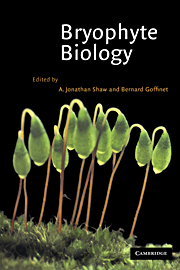Book contents
- Frontmatter
- Contents
- List of contributors
- Preface
- 1 Anatomy, development, and classification of hornworts
- 2 Morphology and classification of the Marchantiophyta
- 3 Morphology and classification of mosses
- 4 Origin and phylogenetic relationships of bryophytes
- 5 Chemical constituents and biochemistry
- 6 Molecular genetic studies of moss species
- 7 Control of morphogenesis in bryophytes
- 8 Physiological ecology
- 9 Mineral nutrition, substratum ecology, and pollution
- 10 Peatlands: ecosystems dominated by bryophytes
- 11 Role of bryophyte-dominated ecosystems in the global carbon budget
- 12 Population ecology, population genetics, and microevolution
- 13 Bryogeography and conservation of bryophytes
- Index
4 - Origin and phylogenetic relationships of bryophytes
Published online by Cambridge University Press: 05 June 2012
- Frontmatter
- Contents
- List of contributors
- Preface
- 1 Anatomy, development, and classification of hornworts
- 2 Morphology and classification of the Marchantiophyta
- 3 Morphology and classification of mosses
- 4 Origin and phylogenetic relationships of bryophytes
- 5 Chemical constituents and biochemistry
- 6 Molecular genetic studies of moss species
- 7 Control of morphogenesis in bryophytes
- 8 Physiological ecology
- 9 Mineral nutrition, substratum ecology, and pollution
- 10 Peatlands: ecosystems dominated by bryophytes
- 11 Role of bryophyte-dominated ecosystems in the global carbon budget
- 12 Population ecology, population genetics, and microevolution
- 13 Bryogeography and conservation of bryophytes
- Index
Summary
Introduction
The origin of a land flora during the Upper Ordovician–Lower Silurian border (± 440 millions years ago) represents a significant evolutionary event in the history of life. The subsequent evolution of a diverse auto trophic land flora created the conditions necessary for the diversification of a terrestrial hetero trophic fauna (Behrensmeyer et al. 1992). Today the land flora comprises roughly 300000 species distributed among three major groups, the bryophytes, the pteridophytes, and the seed plants. Considering the evolutionary significance of land plants, as well as their dominance and thus their ecological importance in today's biosphere, it is not surprising that evolutionary biologists are investing much time and resources in understanding the transition to land, and the relationships between major lineages of terrestrial plants. Elucidating the evolution of early land plants may allow for a better understanding on how these plants overcame new obstacles encountered in a terrestrial habitat. Character innovations that coincide with exposure to new selective forces can then be examined in a phylogenetic context for their evolutionary significance or potential adaptive value (Knoll et al. 1984, Knoll & Niklas 1987).
- Type
- Chapter
- Information
- Bryophyte Biology , pp. 124 - 149Publisher: Cambridge University PressPrint publication year: 2000
- 21
- Cited by



